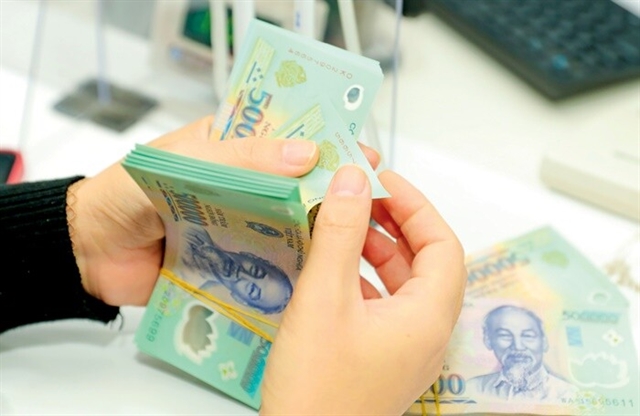 Economy
Economy


|
| A bank teller counts cash in a transaction office in Hà Nội. Interest rates for one-week, two-week and one-month loans in the interbank market have stayed at the lowest level in the past eight months. Photo vietnamfinance.vn |
HÀ NỘI — Việt Nam’s banking system is showing signs of returning to a period of money surplus as no bank needs the State Bank of Vietnam's (SBV) capital in the open market operation (OMO) channel and overnight interbank interest rates have dropped sharply.
Though the SBV has offered cheaper interest rates with longer-term loans in the OMO channel, no banks have taken part in the SBV’s offers. April 3 marked the 10th consecutive session that the SBV failed to lend capital on the OMO channel.
The move took place after the SBV decided to reduce several policy interest rates by 0.3 - 0.5 percentage points from the beginning of last week.
Previously, the SBV also increased the term for loans in the OMO channel from seven and 14 days to 28 days after reducing some policy interest rates on March 15.
The fact that banks are not interested in the SBV's lending channel is understandable as the interest rates for the SBV’s loans in the OMO channel have decreased but are still higher than those in the interbank market. Therefore, instead of looking to SBV loans that have a higher capital cost, banks are prioritising borrowing from each other to meet their liquidity needs.
According to the SBV, the average overnight interbank lending interest rate fell to 1.12 per cent on March 20. Though the rate inched up compared to the previous two sessions, it was the lowest overnight interest rate since the middle of July 2022 and was equivalent to the rate in the ‘cheap money’ period from the beginning of 2020 to the middle of 2022.
Similarly, interest rates for one-week, two-week and one-month loans in the interbank market were also at the lowest level in the past eight months.
Interbank interest rates continuously fell in the second half of March as the liquidity of the banking system became more abundant than in the previous period. In fact, in recent statements, SBV leaders have affirmed that the liquidity of the banking system was very abundant when the SBV bought a large amount of US dollars and pushed a corresponding amount of Vietnamese đồng into circulation.
According to SBV Governor Nguyễn Thị Hồng, in the first quarter of 2023, the SBV bought US$4 billion, which meant injecting a corresponding amount of cash into the market. The injection has helped the liquidity of the banking system remain abundant.
In addition, Hồng said, deposits in the banking system have also risen sharply since Lunar New Year.
Commercial banks have lowered their deposit rates further since the SBV’s latest rate cuts came into effect on April 3. Việt Nam’s big four State-owned commercial banks reduced their deposit rates by 0.1-0.3 percentage points per year. Accordingly, interest rates for deposits from one to 11 months range from 4.9 per cent to 5.8 per cent per year, and the rates for deposits of 12 months and longer are set at 7.2 per cent.
At a recent press conference on reviewing banking activities in the first quarter of 2023, Phạm Chí Quang, director of the SBV’s Monetary Policy Department, also said liquidity in the banking system is at a large surplus.
“Bank liquidity is in excess. This is demonstrated by two indicators. First, the deposit balance of credit institutions at the SBV far exceeds the required reserve level and this movement has occurred since February this year. Second, the interbank interest rate dropped very sharply, currently the overnight interest rate is only about 0.7-1.2 per cent per year," Quang said.
Quang attributed the excess liquidity in the banking system to low credit growth in the first quarter of 2023 that did not meet expectations.
According to an SBV report, credit of the whole economy in the first quarter of 2023 increased by only 2.06 per cent compared to the end of 2022, the lowest rise in the past three years. With this growth, the whole banking system net lent to the economy only about VNĐ245.6 trillion in the first quarter of this year.
"It cannot be said that banks do not want high credit growth, but credit demand of the economy is very low, making it difficult for banks to lend," Quang explained.
According to the SBV’s deputy governor Đào Minh Tú, credit growth of 2.06 per cent in the first quarter of 2023 did not meet expectations due to various reasons. Specifically, in the first quarter of this year, uncertainties in the domestic and international markets had a significantly adverse impact on firms and many of them faced difficulties, which caused credit demand to slow. In addition, credit growth was low in the first quarter so some projects and investment activities were interrupted by the Lunar New Year holiday.
Normally, credit growth at the beginning of the year is lower than in other quarters. However, it is necessary to continually watch indicators to assess the difficulties of firms and economic sectors to timely take measures, Tú noted. — VNS